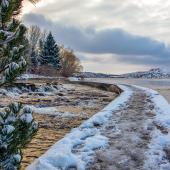Dream Streams
Exploring the inconspicuous.
Mill Creek in the Paradise Valley does not have its own hatch report in the fly shops; you have to ask the guy behind the counter what’s good or else bring a decent selection of dries and do some improvisation. Nymphing is out of the question: by the time the creek clears up after runoff, downed trees crisscross riffles like a pile of pick-up sticks. You’ll need a practiced sidearm and a clean roll-cast to avoid snagging the vegetation back of you. A gravel road parallels the water, but some approaches are pretty hairy and you may have to negotiate a few logjams or skirt a shrubby willow patch before you find a decent run. And if you’re looking for a money shot gripping some monstrous, hook-jawed salmonid, you’re better off putting in downstream. Here, you’ll get into healthy cutthroat, but a four- or three-weight rod is sufficient, even preferable, to bring them in.
Given these technical considerations, I’d never thought to fish Mill Creek, or any mountain stream for that matter, until one summer a few years ago while my father and I were remodeling an old Forest Service cabin there. At noon, we’d clean our hands in the creek and eat our sandwiches on a big quartz boulder. Across from us, veiled in the shade of the tall pines, we saw what appeared to be a half-dozen pygmy trout snapping at the surface of the water. We threw in a black beetle upstream and followed its progress as it descended from one pool to the next like a tiny kayaker in a series of rapids and then WHAM! A prismatic splash of sunlight and the cutthroat was back on the streambed, a narrow silhouette idling in the current.
It was a revelation to me: trout lived in this little aquatic obstacle course and I’d never even known. And not just lived, as it turns out, but thrived. During the spawn, I’ve observed bewilderingly large maple-colored cuttys in a mere six inches of water up Passage Creek, a minor feeder to the Mill Creek drainage. These inconspicuous mountain streams are home to the most beautiful trout in America. Fish here have a particular brilliance: the patterns and colors of their river-cruising kin seem compressed and vivified into a sleek subalpine form, concentrated as the burst of a wild strawberry compared to those impressively plump but proportionately flavorless domestic fruits.
Streams distill fishing to its purest form. All the extraneous instruments and apparel are stripped away, and you have to rely on downright cunning. Unlike blind casting from a boat, hitting this hole or that riffle, stealth and soft landings are paramount. Mountain streams are crystal clear, upset only by the bubbling of the oxygen-rich water. Fish spook easily. Piling up a wad of line and letting it unfold in the current isn’t an option. Work up creeks from downstream, casting above the feature or pool where you want the fly delivered. In some densely vegetated or exposed streams, arrow casting (using the flex-tension of the rod like a bow to propel the fly) or dapping (allowing only the fly, not the tippet or leader, to touch the water) are foxy presentation tools. One fish or five to seven casts per pool is a good rule.
Since that summer on Mill Creek, I’ve found that streams are the stuff anglers dream about: cold water, piquant trout, thrilling pursuit. Don’t hesitate to strike out for the headwaters that get ignored by the press. Trout heaven is often found up a godforsaken road, on the current of a wild, wild stream.
Montana's spring creeks are among the most coveted trout waters in the world. Flanked by lofty peaks and fed by natural springs that keep the water temperature and flow consistent year-round, these crystal-clear streams provide habitat for a multitude of insect types—and the abundant, often-goliath fish that feed on them. What's more, tjhey afford pristine fishing opportunities every month of the year.
While there are a few publicly accessible spring creeks in the Bozeman area, the most thrilling experiences tend to occur on private land. Most landowners limit the number of anglers and charge a rod fee. Some of the more renowned streams are DePuy, Armstrong, and Nelson, all of which lie in the Paradise Valley. Another great option is O'Dell's near Ennis.
Be warned: even expert anglers may be put to the test here. Careful attention to technique is crucial: hatches must be perfectly matched and presentation must be precise. The smart, spooky fish require maximal stealth—expect to find yourself on hands and knees more than once, stalking a feeding trout you spotted near the bank.
Frustration, excitement, cynicism, joy—these are some of the emotions that may bubble to the surface while attempting to fish spring creeks. They're a challenge, yes, but determination pays off. There's no better environment to test and sharpen your skills, and at the very least, you're sure to come away with a fine memory of chasing trout in a beautiful Montana setting.—Stephanie Schmieding












